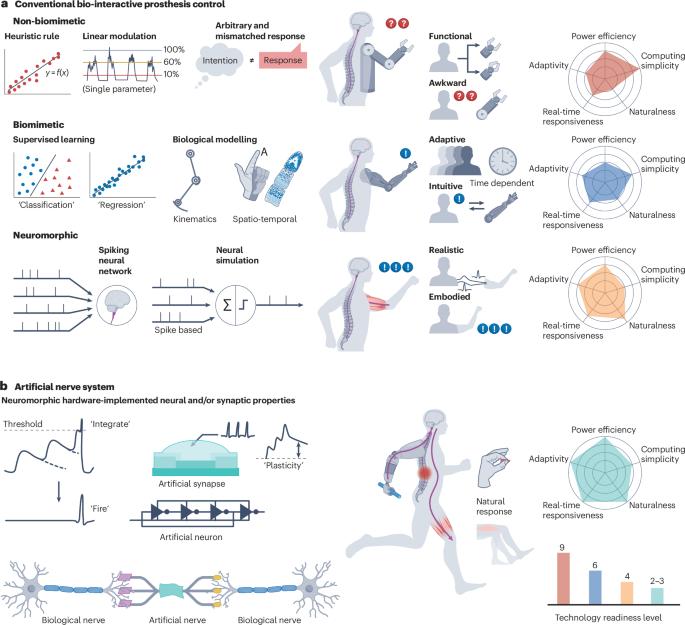Artificial nerve systems for use in bio-interactive prostheses
引用次数: 0
Abstract
Artificial nerves aim to replicate the functioning of the biological nervous system and are expected to lead to important advances in bio-interactive prosthetics. Population ageing is expected to increase the number of patients with neurological deficits or disorders worldwide and to drive increasing global demand for effective prosthetic solutions. Most current bio-interactive prostheses use traditional complementary metal–oxide–semiconductor digital computing and are primarily focused on the restoration or rehabilitation of physiological functions from an electronics perspective. These devices often place little emphasis on neurological compatibility. By contrast, artificial nerve systems consisting of neuromorphic devices offer a promising and neurologically compatible method to either bypass damaged biological nerves or act as an interface between biological nerves and a prosthesis. Artificial nerves are designed to restore lost sensory and motor functions in a similar way to biological nerves by providing biologically plausible and simplified signal processing. Moreover, artificial nerves provide power-efficient control of prostheses and improve users’ interactions with their environment. This Review explores the achievements and limitations of conventional bio-interactive prostheses and describes advances in artificial nerve systems that aim to increase functionality through the seamless integration and neuromorphic processing of biological signals. This Review provides an overview of non-biomimetic, biomimetic and neuromorphic approaches to bio-interactive prosthetics. Kim et al. highlight the advantages and challenges of artificial nerve systems for reducing computational complexity, improving biocompatibility and restoring natural sensory and motor functions in patients with neurological deficits.

用于生物交互假体的人工神经系统
人工神经旨在复制生物神经系统的功能,并有望在生物交互修复领域取得重要进展。人口老龄化预计将增加全球神经功能缺陷或疾病患者的数量,并推动全球对有效假肢解决方案的需求不断增长。目前大多数生物交互假体使用传统的互补金属氧化物半导体数字计算,主要侧重于从电子学角度恢复或康复生理功能。这些设备通常很少强调神经系统的兼容性。相比之下,由神经形态装置组成的人工神经系统为绕过受损的生物神经或作为生物神经和假体之间的接口提供了一种有前途的神经相容方法。人工神经的设计是通过提供生物学上合理和简化的信号处理,以类似于生物神经的方式恢复失去的感觉和运动功能。此外,人工神经提供了对假肢的节能控制,并改善了用户与环境的互动。这篇综述探讨了传统生物交互假体的成就和局限性,并描述了人工神经系统的进展,旨在通过生物信号的无缝整合和神经形态处理来增加功能。本文综述了生物交互修复的非仿生、仿生和神经形态方法。Kim等人强调了人工神经系统在降低计算复杂性、提高生物相容性和恢复神经功能缺陷患者的自然感觉和运动功能方面的优势和挑战。
本文章由计算机程序翻译,如有差异,请以英文原文为准。
求助全文
约1分钟内获得全文
求助全文

 求助内容:
求助内容: 应助结果提醒方式:
应助结果提醒方式:


